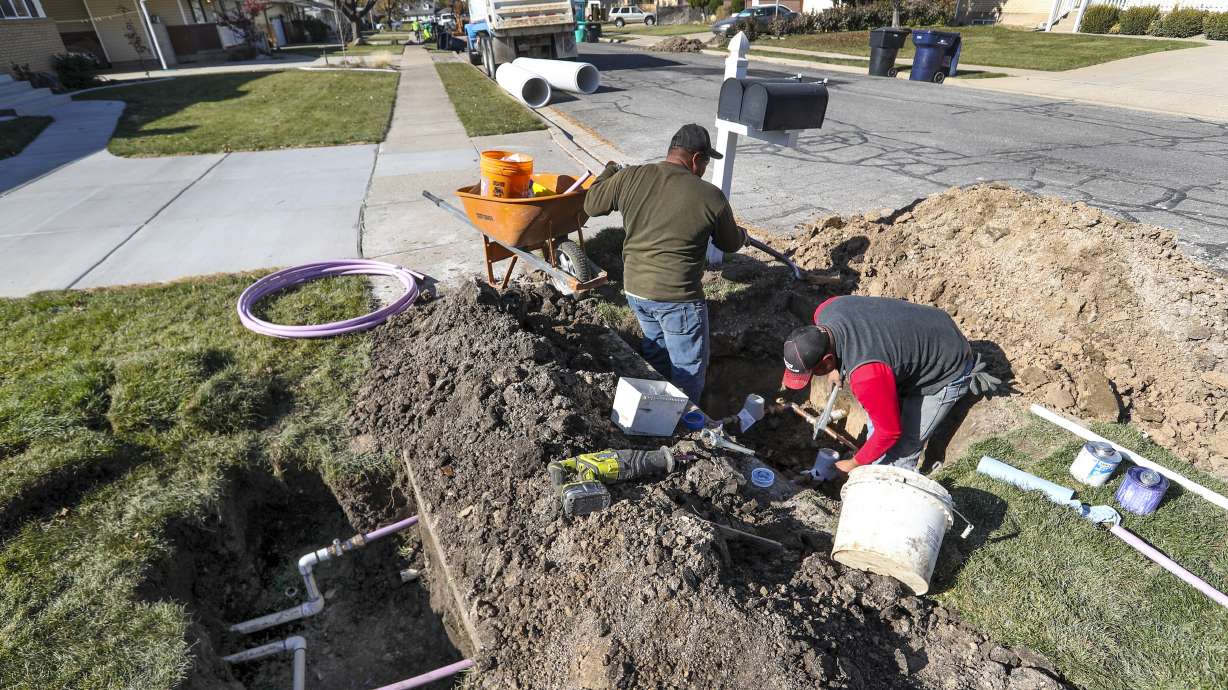Estimated read time: 4-5 minutes
This archived news story is available only for your personal, non-commercial use. Information in the story may be outdated or superseded by additional information. Reading or replaying the story in its archived form does not constitute a republication of the story.
SALT LAKE CITY — The Utah Board of Water Resources on Thursday approved $190 million in grants toward dozens of projects that will add about 114,000 meters, helping cover more than half of the remaining unmetered secondary water connections in the state in the coming years.
The list of projects was long enough that the board heard and voted on all of them during three segments throughout the day, along with other state water-related items also brought up before the board.
"This is really a historic day," said Candice Hasenyager, the director of the Utah Division of Water Resources, between sessions of the meeting.
Secondary water is used specifically for irrigation systems, lawns, gardens, parks, landscapes or any other open areas. There are about 260,000 secondary, outdoor water connections statewide; however, about 85% were unmetered entering the year. Utah leaders have warned about the need for water metering for years, noting that the lack of metering makes it difficult to really know how much water is being used for secondary purposes.
These meters are important because they can better project how long into the irrigation season a certain water user can go before running out of water. Hasenyager adds those who have water meters also have been able to reduce water consumption by 20% to 30%.
"When we add that up across the state, that total (provides) really significant numbers," she said.
It's why the Utah Legislature approved a plan earlier this year to set aside $250 million in federal American Rescue Plan money for secondary water metering in the state. The funds must be used by the end of 2026. The Legislature also passed a bill requiring secondary water suppliers to have a meter on any secondary water connections by the start of 2030.
About 70 water conservancy districts and irrigation companies to municipalities and other water users applied for grants during the initial round of funding, said Marisa Egbert, a funding section manager with the Division of Water Resources.
One applicant, the Country Classic Estates homeowner association in Bluffdale, withdrew its application for $35,000 in grants for 42 of its secondary water connections just before it was up for approval Thursday afternoon, citing some questions it needed to sort out. It was the smallest of the proposed projects.
The 114,000 meters requested account for about 57% of the remaining unmetered secondary water connections, according to Hasenyager. The approved projects ultimately cover a little more than three-fourths of the allotted money and have an estimated savings of about 54,000 acre-feet annually once all the meters are installed in the next few years, which equates to roughly 17.6 billion gallons of water — or the size of a decent-sized reservoir.
"So think of East Canyon, think of Sand Hollow," Hasenyager said. "This is a big number and it will make a difference (in) how we use water in the future."
All grants can cover up to 70% of the entire cost of a project, while an applicant must pitch in at least some of the remaining costs. Several of the applicants in this round of funding also sought loans at 1% interest from the Utah Board of Water Resources.
Lehi, for example, will receive $10 million in grant funds, which will cover most of its nearly $14.3 million project to install 5,700 meters across its city. It also received a low-interest loan to cover more than $3.6 million of the remaining cost of the project, which is estimated to reduce water consumption by 1,368 acre-feet annually in the coming years.
The full list of projects can be found here.
As for logistics, Ronald Mortensen, representing the South Davis Water District, asked the board Thursday what could happen if a district runs into supply chain issues, labor shortages or other economic factors that could delay a project from being completed by the end of 2026. After the first meeting concluded, he also noted that taxpayers may have to pony up the money needed to cover the 30% that grants don't cover, which can be burdensome for some residents.
Utah water officials said loan funds will be made available if applicants miss the 2026 deadline because all grant money will disappear then. They also advised that cities and water districts should ask around different metering manufacturers because some may have meters in stock while others don't, to avoid possible setbacks caused by material shortages.
Meanwhile, Egbert says all the water saved through water metering can go toward the culinary supply instead, which can help supply the water needed for future development as Utah continues to grow, because less water is used inside homes than outside of them. The funds also help state water officials think about other water-saving projects beyond secondary metering.
There are still tens of millions of dollars left for the program, which she hopes can be used for the 43% of secondary sources not included in Thursday's package. Those places will have until 2030 to comply with Utah's new law.










